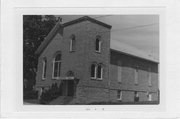| Additional Information: | A 'site file' exists for this property. It contains additional information such as correspondence, newspaper clippings, or historical information. It is a public record and may be viewed in person at the Wisconsin Historical Society, State Historic Preservation Office.
ROUND ARCHED WINDOWS AND DOORWAYQUOINS IN FOUNDATIONFLAT ROOFED SQUARE TOWER ON CNR
Additional Comments, 2023:
The Methodist Episcopal Church is a one-story building with cream brick walls sitting on a raised, regularly coursed, stone foundation. The main block of the building was built in 1867 and has a gable roof. The original building included a belfry and steeple on top of the roof, but in 1898 the church was remodeled based on plans by Madison architects Conover and Porter. The steeple was removed and the corner tower was added. The 1867 main entrance was moved to the tower and on the main elevation, two round-arched windows were replaced with a much larger round-arched window. The 1867 entrance was converted to two window openings in the raised basement.
The church still retains the main block and corner tower, but the belfry from the tower has been removed. The tower has several round-arched openings enclosed with bricks except for an upper level opening on the main elevation that has a stained glass window. All of the tower openings are accented with round brick arches. The original entrance of the tower had a pair of wood doors, but they were replaced with a modern steel door and sidelight. The entrance’s gothic-arched stained glass transom is extant.
Openings in the main block of the church are also round-arched with round brick arches and they are all enclosed with bricks. The larger opening on the main elevation is also enclosed with bricks and has a rectangular opening filled with glass blocks. Openings in the raised basement story are either enclosed with bricks or filled with four-light windows. A street-level entrance to the church has been returned to the original 1867 main entry location. It has a later 20th century metal and glass door and a metal and glass sidelight. A gable-roofed overhang sits above this entrance.
The rear elevation has a shallow apse shaped like a bay window and the two openings in this bay are enclosed with brick. A concrete block ell projects from the basement on this elevation, an extension made for the basement furnace room.
The main entrance in the tower leads into a foyer with a large staircase covered with carpeting. The staircase leads up to the sanctuary and has a balustrade of heavy turned posts with a square newel post. The staircase also leads down to the basement. The walls are covered with both wainscoting and painted wood paneling. In the foyer there is a late 20th century dropped acoustical panel ceiling.
The sanctuary appears to have been remodeled in 1898 with the same type of wood paneling and wainscoting as the foyer in the tower section. Mid-20th century acoustical tiles cover the sanctuary ceiling. The altar area is recessed behind an arch with a wood molding. In this area, the older wainscoting has been removed in favor of mid-20th century wood paneling. The sanctuary floor is covered with vinyl flooring.
The basement has features from the mid-to-late 20th century, including a dropped late-20th century acoustical panel ceiling, fluorescent lighting, mid-20th century wood paneling, and a mid-20th century men’s and women’s bathroom. A large kitchen sits at one end of the basement. It has a commercial stove and 1970’s era cabinetry and countertops.
History
The Methodist Episcopal Church in Sun Prairie was built in 1867 as a simple 19th century brick church with steeple and round-arched openings in the Romanesque Revival style. In 1898, the church underwent a remodeling that enhanced the Romanesque Revival style. The large square tower had a belfry with arcaded round-arched openings and a hip roof with modillions. Two of the old round-arched openings on the main elevation were replaced with a large round-arched opening and a large round arch decorated a new, larger, entrance in the tower.
The church was used until 1961 when it was sold to the Catholic Order of Foresters, an insurance-providing fraternal organization. This group held meetings and events at the church. In 2023, the building was sold to a private owner. During the ownership of the Foresters, the belfry of the tower was probably removed (a 1977 photograph shows it already gone) and most windows were bricked up (also seen in the 1977 photograph). The main elevation windows and those of the tower were not enclosed until after 1977 (photograph).
(Carol Cartwright, 2023)
|
|---|





